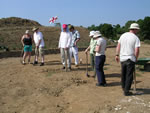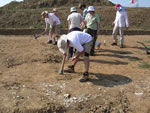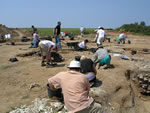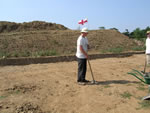|
   

Click
on any thumbnail to enlarge
Day
1 - Site introduction and Geophysics - Heath and Safety and Excavation
Discussion
session on previous years digs and observations made.
The
Villa is a Classic Romano/British design with the gallery and two side
rooms.
Round
and Rectangular houses found together i.e. Celtic round and Roman rectangular
Evidence
of medieval wall robbing found to build the nearby church
Classic
position of a villa near road and river transport and also wood for
timber and charcoal.
Interesting
observation is that only 5% of finds are on the surface at any one time
Equipment
Discussion
and hands on use of the types of equipment that can be used to aid the
dig, Magnetometers, Metal detectors, Dowsing, Bowsing and Geophysics
etc.
Resistively
Meters
 The
first type of equipment available is the Receptivity Meter. For most
amateur groups, it is the most commonly used piece of equipment as it
is both the cheapest and easiest to use. The hardware usually consists
of a box of electronics mounted on a carrying frame, with wires leading
down to a pair of metal spikes that are inserted into the ground. An
electric current is passed through the ground and the box measures the
resistance to the electrical current passing through the ground, hence
the name resistively meter. The amount of resistance is affected by
how much moisture there is in the soil. If there is a lot of moisture
in the soil, you will get low resistance as the electric current passes
through the wet ground easier. Conversely, if there is little moisture,
then there is high resistance to the electric current. The problem with
this setup is that the resistively is also dependent on the amount of
contact the metal probes have with the ground, so most meters have a
cable running to additional set of fixed probes that help it work out
how much contact resistance there is. The
first type of equipment available is the Receptivity Meter. For most
amateur groups, it is the most commonly used piece of equipment as it
is both the cheapest and easiest to use. The hardware usually consists
of a box of electronics mounted on a carrying frame, with wires leading
down to a pair of metal spikes that are inserted into the ground. An
electric current is passed through the ground and the box measures the
resistance to the electrical current passing through the ground, hence
the name resistively meter. The amount of resistance is affected by
how much moisture there is in the soil. If there is a lot of moisture
in the soil, you will get low resistance as the electric current passes
through the wet ground easier. Conversely, if there is little moisture,
then there is high resistance to the electric current. The problem with
this setup is that the resistively is also dependent on the amount of
contact the metal probes have with the ground, so most meters have a
cable running to additional set of fixed probes that help it work out
how much contact resistance there is.
The
amount of water present in the soil is affected by some archaeological
features. For example, if you have a wall under the surface, then there
is less soil to store moisture, which will evaporate quicker, making
that patch of ground high resistance. Conversely, if you have a ditch
or pit, it can store more moisture for longer, giving a lower resistance.
Resistance readings taken in a grid can then be turned into an image
and interpreted to look for relevant archaeological features. The problem
with resistively is that results can be rather poor if the ground is
too wet or too dry, i.e. if there is little relative difference between
the resistance for different depths of subsoil.
Magnetometers
- great for finding kilns
 The
second most commonly used piece of equipment is the magnetometer. It
is rather more expensive and tricky to use, but is favorites with a
lot of people because you can do a survey with a magnetometer a lot
quicker than with a resistively meter. The
second most commonly used piece of equipment is the magnetometer. It
is rather more expensive and tricky to use, but is favorites with a
lot of people because you can do a survey with a magnetometer a lot
quicker than with a resistively meter.
Magnetometers
measure the local magnetic field strength. As well as the earths magnetic
field, some archaeological features have a measurable magnetic field.
Burning will cause substances to become magnetised, metals such as iron
have a strong magnetic field, and even the fill of a ditch will show
up because there are magnetic particles in soil, so if you have a deeper
depth of soil because of a ditch, you will get more of a magnetic field
to measure.
Hands
on use of a Resistively Meter and metal detector
We
plotted a 20m sq. grid to perform the Geophysics on and took readings
at every meter. It soon became apparent that we were finding a large
wall foundation due to the high resistance. The field we selected had
already had a full survey completed and they believe it is a 2nd Roman
bath house that will be excavated next year as part of the continuing
dig. The device can be linked to a PC and the software will draw the
plots for you. A metal detector was demonstrated and guys could have
a go themselves.
Health
and safety on site covering machinery, digging plant and hard-hats.
 
An
important topic as backing onto one of these diggers can be very painful
LOL
Selecting
the right digging equipment for the site, it's location, access and
size is critical as it is an expensive exercise. Caterpillar machines
have to be towed to the site and require trucks to take the spoil back
and forward to the area that is it dumped. They have the ability to
rotate 360 degrees and are very quick. The JCB can be driven on the
road to the site but uses only it's rear bucket so it does not drive
over the cleared area. They are a lot slower at removing the top soil
to get down to the Archaeology.
We
were then shown all the basic hand digging tools used on the site including
mattocks, picks, trowels, brushes etc. We were shown the correct use
of the tools and finally let loose on the excavation site with strict
supervision. As we troweled a large area together we started to uncover
a series of post holes that ran parallel to one of the main walls and
it is believed they are a covered way. Even within quite a small area
we uncovered Roman pottery and animal bones.
|





